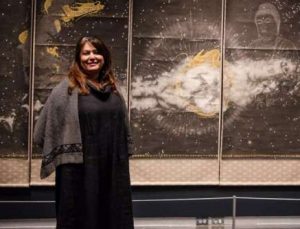I’ve recently returned from a Dunhuang tour led by Mrs. Mei-yin Lee, one of Hong Kong’s most sought-after guides and thinkers on Chinese culture. There are many sites of Buddhist beauty in and around the county-level city. But the Yulin Caves (???L?]), or the Gorge of Ten Thousand Buddhas (?U???l), struck me as being even more beautiful and unique than the Mogao Grottoes (?????]). True, Mogao is larger, more famous, and contains more sculptures and cave art. However, Yulin’s sanctuary combines a deep desert canyon with a flowing river and lush greenery by the sandy banks. This miraculous unity of elements (sand, water, and foliage) haunted me from the moment I stepped off the bus to look down at the oasis gorge. The scorching hot yet dry weather, just like the yawning mouth of the ravine and the darkness of its Buddhist caverns, seemed both gentle and forbidding.
Even the name “Yulin” indicates fertility and verdant life. The site is named after the tall, abundant elm trees that line the riverbanks, of which the water is muddy from the silt and sand it touches. The lush vegetation and trees that make up this canyon is thanks not only to nature’s primeval blessing in the form of the river, but the presence of dedicated human irrigators and farmers since the Tang Dynasty. The Tanguts of Western Xia were particularly active here, and like the greenery that now flourishes beside Yulin’s canyon river, they also thrived in the desert at the border of nourishment and drought.
The Tanguts ruled over the entire Dunhuang area from 1068 until their annihilation by the Mongols in 1227. They had enough time to introduce not only their Tibetan-influenced esoteric Buddhism, but also apply ground lapis lazuli to frescoes of Avalokiteshvara, Manjusri, and Samantabhadra. The most beautiful is commonly agreed to be the third in Cave Three. The most evocative caves include images of esoteric deities from Tibet such as Fifty-faced and Eleven-faced Avalokiteshvara or Water-Moon Avalokiteshvara, or “tantricized” images of gods like Vajrapani as a wrathful protector in Cave Ten. Vajrayana transmissions from Tibet, such as the Garbhadhatu and Vajradhatu mandalas or those featuring the five dhyani Buddhas, can’t be found at Mogao.
The quality of Tangut artwork within Yulin’s grottoes, especially in Caves Two and Three, are as remarkable as any piece made at Mogao during the high Tang period. These murals represent the unity of Tangut devotion and assimilated Han expertise. As such, they possess an austere elegance that Tang paintings lack due to the former’s emphasis on lapis and downplaying of heavier colors like deep green and bright red. Just as the Sui, Tang, and other dynasties developed special artistic touches for their apsaras (the famous fei tian ???? in Chinese culture), Tangut depictions of animals are fantastic and mythical. Cave ten boasts horses and deer frolicking about in clouds that are themselves in dynamic movement (you can tell which direction the clouds are moving by their tails), alongside horned creatures and other mythical beasts.
All the caverns on the far side of the bank are forbidden to tourists, and as such there isn’t as much to explore as the more famous Mogao sites. The value and preference one attaches to the murals and sculptures within the caves will never be free from a degree of subjectivity. In any case, we were not permitted to take photos within the grottoes that we were granted access to. It is only taking in the environment alone that I felt Yulin had a bit more to offer.I was so enchanted by the uniqueness of Yulin that I made a video diary of the site, and asked Taiwan-based DJ and “sound-jeweler” MoShang for permission to use his music. His remix of Tafubar’s “The Wicked Thoughts of You” seemed a fitting yet bold collaboration for the heritage of Yulin: a tender but strong scar of life in a hot wasteland, fresh with life amidst desolate surroundings. In this video diary I attempted to retain the artlessness of the raw footage, so that the waters, lush foliage, and hardy sands speak for themselves.

















